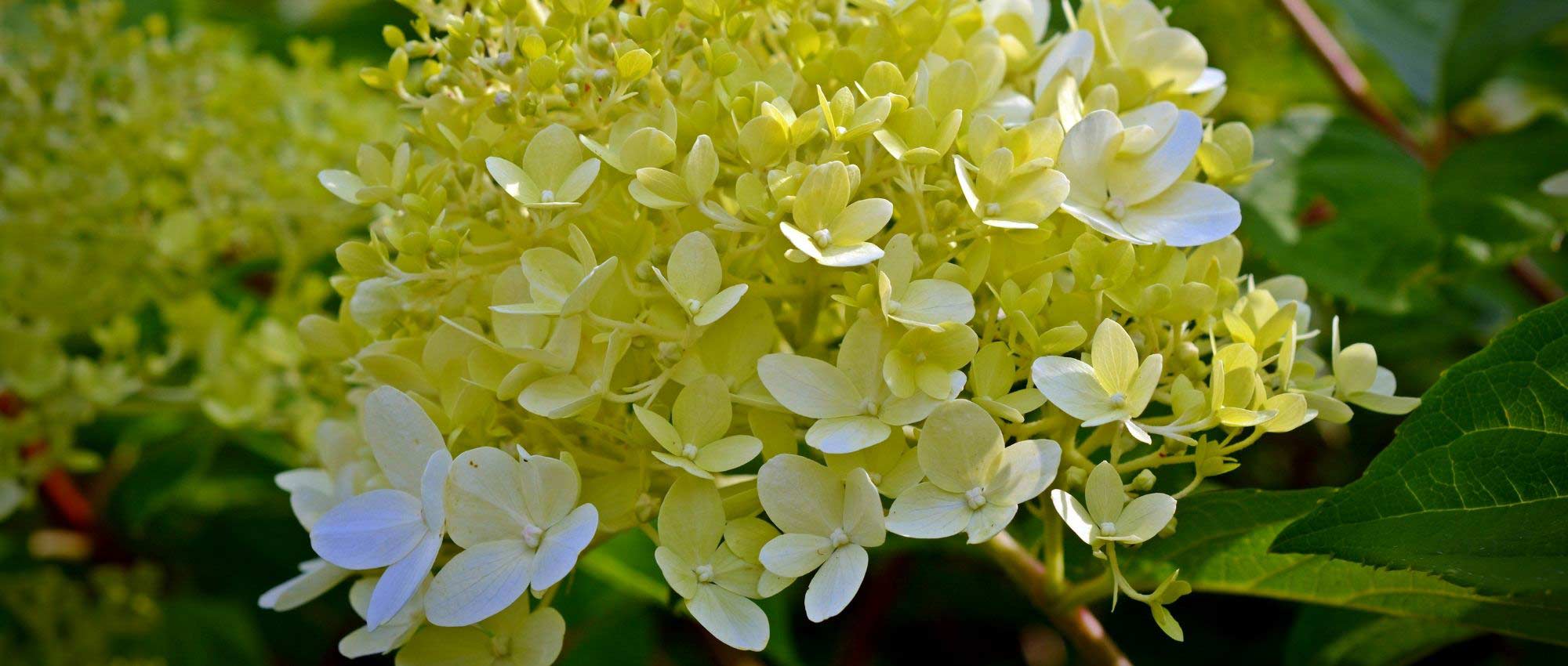
Potted hydrangea: planting and care
Our advice
Contents
Hydrangeas are bushy bushes that offer a generous, long flowering, from June–July through September–October. Flowers are generally grouped into large, generous inflorescences — spherical, flattened or occurring in panicles. They are often pink or blue, but can also be white, red or mauve… Planting in a pot makes it possible to grow hydrangeas even in a small garden with limited space. They can also be placed on a terrace, in a patio or in an inner courtyard, even on a balcony. This lets you keep these bushes close to the house! Although more common to grow them in open ground in the garden, some varieties adapt quite well to planting in a pot. Here we provide all our advice: which hydrangea to choose, how and when to plant it, how to care for it, water it, prune it, etc.
Choose a suitable variety
To grow a hydrangea in a pot, it is best to choose a variety with a relatively compact habit, not exceeding 1 m – 1.20 m tall (bearing in mind that larger hydrangeas reach 2 m tall). Avoid climbing varieties (Hydrangea petiolaris, Hydrangea seemanii…). You can choose Hydrangea serrata, which are fairly compact: for example, discover Hydrangea serrata ‘Shojo’, which bears flattened inflorescences in blue. Hydrangea serrata ‘Hakucho’ is a variety that grows up to 80 cm tall and is appreciated for its double flowers of pure white. Its flowering is delicate and romantic! Some Hydrangea paniculata also suit growing in a pot. Hydrangea paniculata ‘Bobo’, for example, is a compact, small variety that does not exceed 70 cm tall and bears panicles of white flowers. You can also choose Hydrangea paniculata ‘Sundae Fraise’. It produces pink inflorescences that form dense panicles. Finally, Hydrangea paniculata ‘Diamantino’ bears white inflorescences. Also discover hydrangeas from the ‘Magical’ range (for example ‘Magical Revolution’ or ‘Magical Harmony’), whose inflorescences change shade over time!
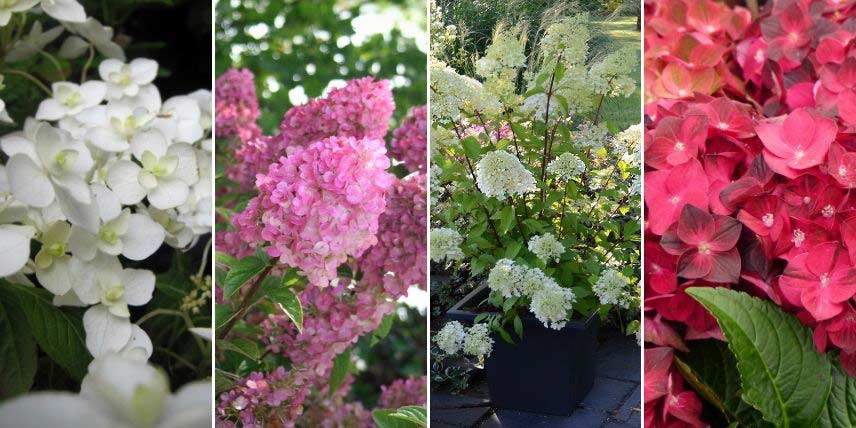
Hydrangea serrata ‘Hakucho’, Hydrangea paniculata ‘Sundae Fraise’, Hydrangea ‘Diamantino’ and Hydrangea ‘Magical Ruby Tuesday’
Read also
Planting hydrangeasWhich container should I choose?
Choose a pot that is fairly large and wide, measuring at least twice the size of the root ball, and with drainage holes in the base, otherwise water may stagnate and suffocate or rot the root system. To give an idea of scale, we recommend choosing a pot at least 50 cm wide and deep. If the hydrangea’s container is small, the bush will quickly feel cramped. Furthermore, smaller pots dry out quickly and therefore require more frequent watering.
Discover other Hydrangeas
View all →Available in 1 sizes
Available in 1 sizes
Available in 1 sizes
Available in 1 sizes
Available in 1 sizes
Available in 2 sizes
Available in 2 sizes
Available in 2 sizes
Available in 1 sizes
Available in 2 sizes
Which potting compost should I use?
To plant your hydrangea, we recommend using a mixture of garden soil, well-rotted compost and coarse sand. Compost provides a rich substrate, allowing your hydrangea to take up enough minerals. You can also add horn meal or a slow-release fertiliser to feed the bush during its growth. Adding a little sand improves drainage and prevents water from stagnating in the pot.
Read also
Colour of hydrangeasHow to plant your hydrangea in a pot and where to place it?
Hydrangea should preferably be planted in early autumn (September–October), but it can also be planted in spring. Work when weather is mild, avoiding periods of frost or extreme heat.
- Place rootball in a basin filled with water, to rehydrate it. Preferably use rainwater, as tap water may be too hard for the hydrangea.
- Take the pot and place a layer of drainage material at the bottom, made of clay pebbles, gravel or pot shards…
- Place the potting mix in the pot. Ideally use a mix of garden soil, well-rotted compost and coarse sand. You can add crushed horn.
- Set your hydrangea in the pot. The collar of the plant should be at the same level as in its previous pot, not buried or raised. Try to position the hydrangea centrally in the pot.
- Replace some potting mix all around, and firm down lightly to avoid air pockets and ensure good contact between soil and roots.
- Water generously.
Place the pot, if possible, in partial shade, so plant can benefit from good light without suffering from scorching sun. Ideal exposure is sun in the morning and shade in the afternoon, protected from burning sun during hottest hours. Pot should preferably be sheltered from wind. Exposure and growing conditions depend, however, on hydrangea you are growing: indeed, Hydrangea paniculata and H. arborescens appreciate sun and tolerate drought better than Hydrangea serrata and H. macrophylla, which prefer cool soils and shady aspects.
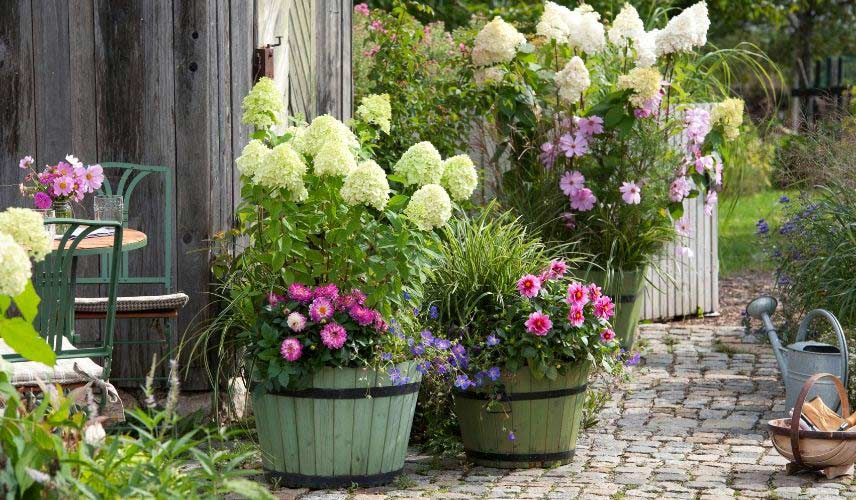
Planted in a large container, hydrangeas can be combined with other perennials to create a colourful display! Hydrangea paniculata ‘Vanille Fraise, Hydrangea paniculata ‘Little Lime’, Carex morrowii ‘Ice Dance’, Geranium ‘Azure Rush’, Dahlia ‘Dalaya Yogi’, Dahlia ‘Maxi Bonita’, Cosmos ‘Sonata Rose’ (photo Friedrich Strauss – Biosphoto)
How to care for a potted hydrangea?
Water your hydrangea regularly. In a pot, potting mix dries out much faster than in the ground! Also water with rainwater rather than tap water, which may be too hard for the hydrangea.
Hydrangea prefers the potting mix to remain fairly cool. You can lay a layer of mulch around the plant, as this will help keep the potting mix cool. It is also a plant that likes rich soils. It will appreciate some applications of fertiliser or well-rotted compost. We recommend applying a little slow-release fertiliser in early spring. You can also mix some horn meal into the potting mix.
Repot in autumn every two years, placing it each time in a slightly larger pot. If the container is already large (or in years when you do not repot), you can simply top-dress.
After flowering, it is best to leave faded flowerheads in place, not cutting them. Preferably wait until early spring (March-April) to remove them. Although unattractive, they help protect the plant from cold during winter. You can carry out a light pruning each year in late winter (March-April). Shorten stems slightly (cutting just above strong, well-formed buds), and remove dead, damaged or poorly placed branches. You can use this opportunity to open up the centre of the bush by removing a few branches. Pruning also helps keep hydrangea compact.
Also discover our video tips on pruning Hydrangea macrophylla:
Hydrangeas grown indoors: a special case
It is possible to grow hydrangeas in pots indoors. Some varieties, such as ‘Colours Your Home’, are particularly well suited. Plant your hydrangea and place the pot in a bright spot, but out of direct sunlight! Avoid overheated rooms: temperature should be fairly stable, without large fluctuations, and ideally between 15 and 20 °C. Indoors, air is sometimes quite dry, so we recommend watering regularly. However, avoid leaving water standing in the saucer under the pot. After enjoying it in your home, you can move the hydrangea outdoors (in the ground in the garden, or in a pot on the patio) in spring, around April.
- Subscribe!
- Contents
































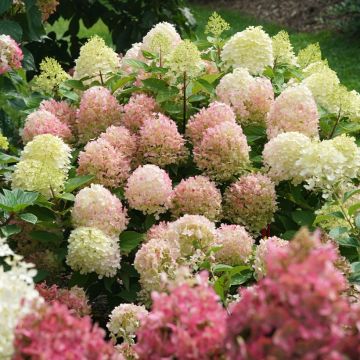
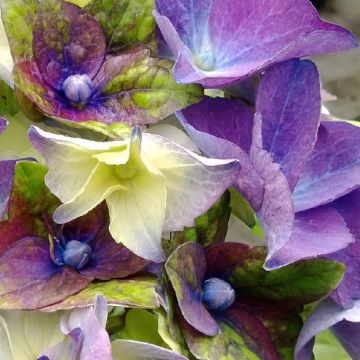
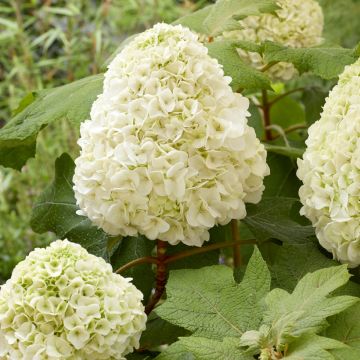
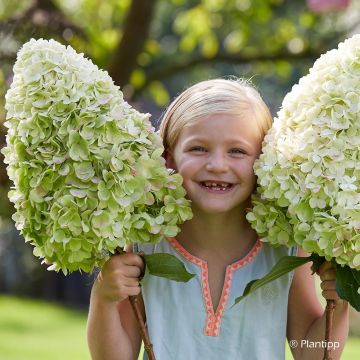
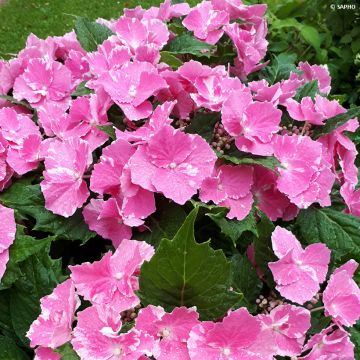
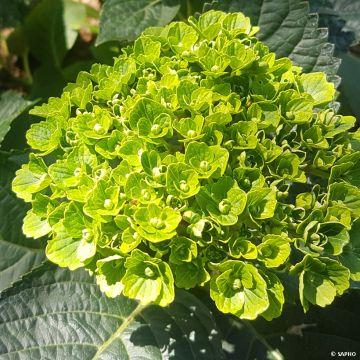
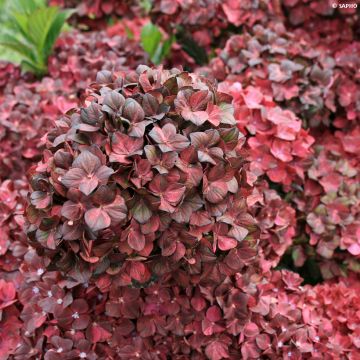
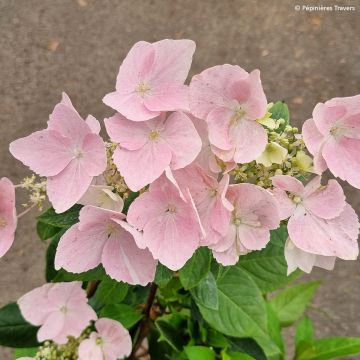
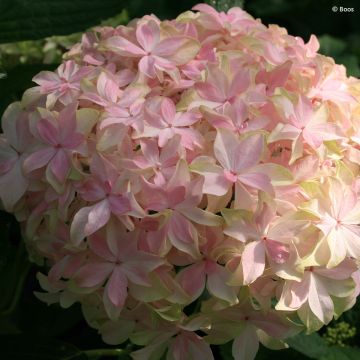
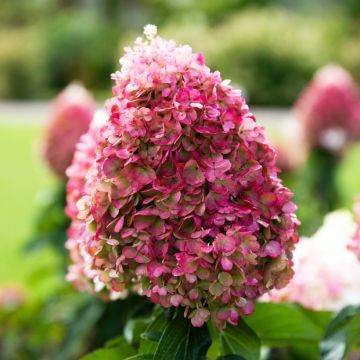
Comments